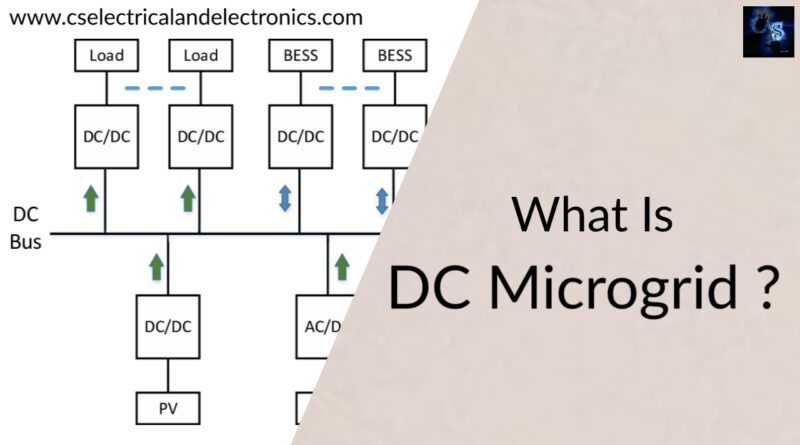What Is A DC Microgrid, Need & Types Of Controlling Strategies
Hello guys, welcome back to my blog. In this article, I will discuss what is a DC microgrid, significance, need to control dc microgrid, types of controlling techniques on DC microgrid, etc.
If you have any doubts related to electrical, electronics, and computer science, then ask question. You can also catch me @ Instagram – Chetan Shidling.
Also, read:
- Electric Vehicle Charging station, Working, Types Of Charging Stations
- Types Of Cell Balancing Topologies, Active And Passive Cell Balancing
- How The Tesla Car Works, Working Of Tesla Car, Autonomous Vehicle
DC Microgrid
What is DC Microgrid?
A Microgrid is a localized electrical network consisting of distributed energy sources (DES), interconnected loads and communication systems. It is a small scale power grid. It can operate either, independently or with the help of main electrical grid. During periods of heavy demand it can act as back-up power for main electric grid.
If the DC terminals from DC bus (feeds DC loads connected to it) are connected to electronic loads, electric vehicles, and batteries then it forms a DC Microgrid. DC microgrids are highly efficient, reliable, easy to control and economic because power quality issues such as reactive power and skin effect are not present. The main advantage of DC microgrid is limited number of power conversion stages and no reactive current circulation.
Significance of DC microgrid
At the point of use, DC systems make sense because many Distributed Energy Resource (DER) systems such as photovoltaic (PV), fuel cells, battery energy storage and low-power rating electronic devices such as laptops, cell phone, wireless phones, DVD players and also Electric Vehicles and light-emitting diodes (LED) are natively DC powered. By using DC microgrid systems, renewable resources can be interconnected very easily.
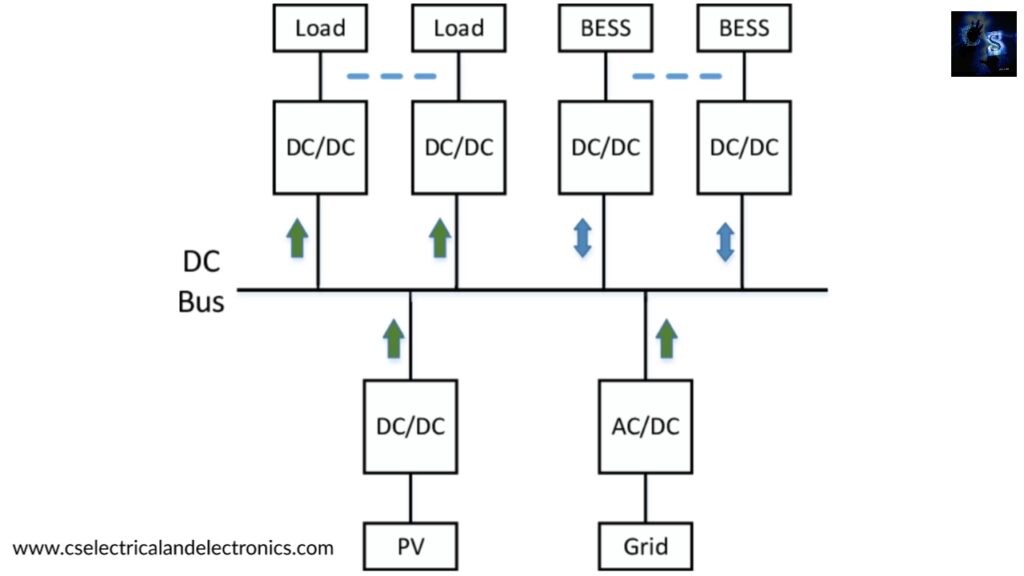
DC microgrid consists of converter based parallel DERs, battery energy storage systems(BESS) and each converter has current, voltage and droop control. By choosing a suitable voltage level, the energy sources and power electronic loads can be supplied more effectively and thereby avoiding a few conversion stages as shown in Fig 1. The Energy Storage System (ESS) can be directly connected to the main DC bus or through a DC-DC converter.
Flexibility in conversion and power level is given by integrating DERs to a common ac or dc grid through power electronic interface. One of the main advantage of microgrid is that, it can be operated in grid-connected mode or islanded mode. To allow microgrid to activate in both grid-connected or island form it can attach and cut off from the grid.
In the first mode, the microgrid can deliver or supply power from or to the utility grid according to its generation and load profiles. Generally, in this mode the voltage and frequency are maintained within the range of grid value. The microgrid should manage the power flow depending on the power generation and the loads. In this case, microgrid control system is used in order to distribute the active and reactive power among the DGs (Distributed Generators) and to manage the power interchange between the microgrid and the utility grid.
When the Microgrid is in grid-joint approach, the electrical energy and regularity of micro-grid are prohibited by using smart grid while the distributed generators provide constant active power and reactive power.
In islanded method, the voltage and frequency of micro-grid are used to by a single dominant distributed generation (DG) in micro-grid. Distributed energy comprises solar (photovoltaic), wind and micro resources such as micro turbines and fuel cells. The power-sharing approach of the DG systems in the islanded microgrid is capable of changing from completely centralized to totally decentralize. In this mode, the flexible operation of the microgrid depends on the reliable and perfect control system.
In a DC microgrid, DC-DC converter is the most important part of a DC distribution system. Electric power supply of separate systems are the most common applications of the DC microgrids such as electric vehicles (EV), spacecraft, data centers, telecommunication systems (Telecom) and also rural areas.
The power in DC grids can be transmitted using two configuration system namely: two-wire (unipolar) and three wire (bipolar) systems. The number of available voltage levels is the difference between these two DC grid configurations.
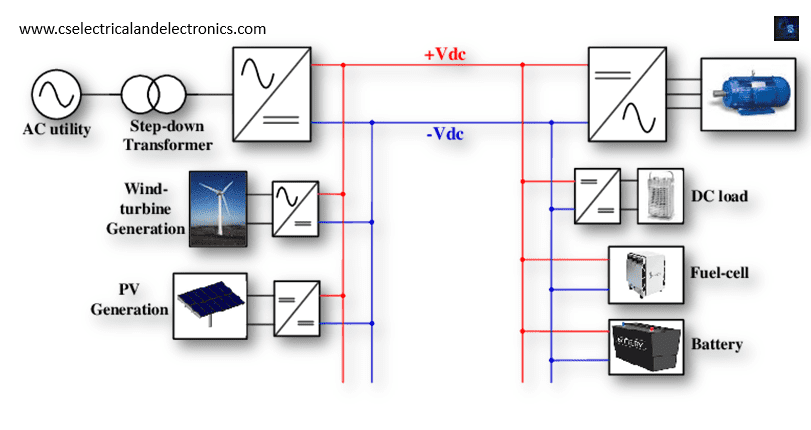
In a unipolar DC system, as shown in Fig 2a, loads and sources are connected between the positive and the negative pole of the DC bus. Selection of DC bus voltage level is a key factor in this system because the energy is transmitted over the DC bus at one voltage level.
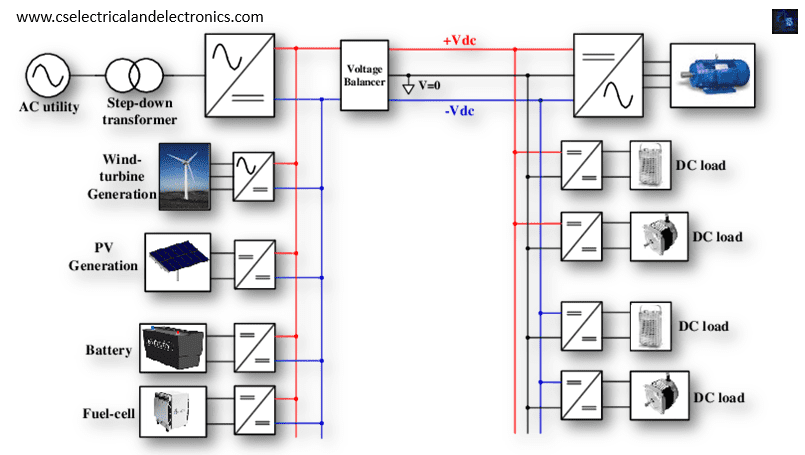
The bipolar system also known as three-wire DC bus system, which consists of +Vdc, −Vdc and a neutral line is shown in Fig 2b. Here customers have option to choose three different voltage levels: +Vdc, −Vdc and 2Vdc. If fault condition takes place in any one of the DC poles, the power can still be supplied by the other two wires (bipolar) and an auxiliary converter. Therefore, the reliability, availability and power quality of the system are increased during fault conditions.
As Bipolar DC system is capable of transmitting power more efficiently that a unipolar system, it is most often used.
Need to control DC microgrid
As depletion of fossil energy and environmental pollution are increasing, exploiting the clean renewable energy resources has become the urgency. But increased penetration of distributed energy resources into conventional power systems has increased its control challenges. Whenever fault happens DGs must disconnect with the main grid which causes a great loss to renewable energy.
As a result, the concept of microgrid is introduced. Thus, controlling of microgrids has become a great issue due to the uncertainty of micro generators and the low level power capacity of microgrid system. This is the reason why we need to control DC microgrid.
Types of controlling techniques on DC microgrid
Control strategies in DC micro grids are divided into three main types: constant-current control, constant-voltage control and droop control.
01. Constant-current control: As the name itself says, Constant-current control aims to keep the output current of microgrid terminal to be a constant. The output current of micro terminal is compared with reference current. The error is imported into PI controller, then the control signal is generated using PWM control. It is usually applied in some special cases. For example, when the required power is too much or too less, there may be great fluctuation in DC bus voltage.
The energy storage system should work under constant-current control to absurd or release a maximum current to help recover bus voltage at a short time.
02. Constant-voltage control: Constant-voltage control is a control strategy to keep the bus voltage constant. The error of the DC bus voltage is given to PI controller. The control signal is generated through PWM control.
03. Droop control: When there is more than one micro terminal to stabilize the bus voltage, the load sharing problem occurs. The most common solution is droop control. Fig .3 represents V-I characteristic line. The load change will bring change in the output current of converters, which further leads to the drop in bus voltage. The relationship of current and voltage is complies with the V-I characteristics line. The control strategy of droop control is the same as that of constant-voltage control except that the reference voltage needs to be replaced by droop voltage.
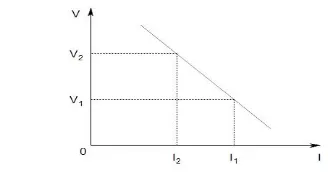
I hope this article “What is a DC microgrid” may help you all a lot. Thank you for reading.
Also, read:
- 10 Tips To Maintain Battery For Long Life, Battery Maintainance
- 10 Tips To Save Electricity Bills, Save Money By Saving Electricity
- 100 (AI) Artificial Intelligence Applications In The Automotive Industry
- 100 + Electrical Engineering Projects For Students, Engineers
- 1000+ Control System Quiz, Top MCQ On Control System
- 1000+ Electrical Machines Quiz, Top MCQs On Electrical Machines
- 1000+ Electronics Projects For Engineers, Diploma, MTech Students
- 1000+ MATLAB Simulink Projects For MTech, Engineering Students

